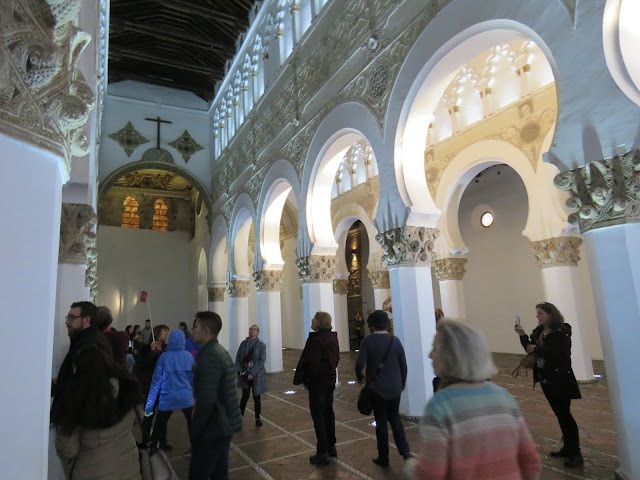November 2018 - Toledo Spain
This was simply stunning!
The Synagogue of Santa María la Blanca (literally Synagogue of Saint Mary the White, originally known as the Ibn Shushan Synagogue, or commonly the Congregational Synagogue of Toledo) is a museum and former synagogue in Toledo. Erected in 1180, according to an inscription on a beam, it is disputably considered the oldest synagogue building in Europe still standing. It is now owned and preserved by the Catholic Church.
Its stylistic and cultural classification is unique among surviving buildings as it was constructed under the Christian Kingdom of Castile by Islamic architects for Jewish use. It is considered a symbol of the cooperation that existed among the three cultures that populated the Iberian Peninsula during the Middle Ages.
The synagogue is a Mudéjar construction, created by Moorish architects for non-Islamic purposes. But it can also be considered one of the finest example of Almohad architecture because of its construction elements and style. The plain white interior walls as well as the use of brick and of pillars instead of columns are characteristics of Almohad architecture. There are also nuances in its architectural classification, because although it was constructed as a synagogue, its hypostyle room and the lack of a women's gallery make it closer in character to a mosque. Though it does not have a women's gallery today, an early twentieth century architect suggested that it did at one time have a one
The focal point of the synagogue is the scallop-shell-topped arch at the center of the building. This was the location of the Torah ark. In many synagogues found throughout the Jewish Diaspora and what is now Israel, the scallop shell motif is a marker for the location where a portable ark should be placed. Evidence from Catholic altarpieces depicts the ark as a tall, movable structure that would fit nicely in this particular niche. It is torpedo shaped, much like a traditional Sephardic Torah scroll case.
The interior features a series of arcades supported on a network of twenty-four octagonal piers and eight engaged piers. These octagonal supports line the central aisle of the synagogue and support the large arcade of horseshoe arches above. The arches rest on intricately detailed capitals with finely carved pinecones and other vegetal imagery. These capitals are Mudéjar in style and are derived from classical, Corinthian antecedents as well as Byzantine concepts.
.




















...lots of beauty to look up at!
ReplyDeleteBeautiful inside!
ReplyDeleteWow! That's gorgeous! And very nicely photographed.
ReplyDelete